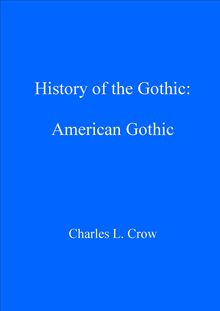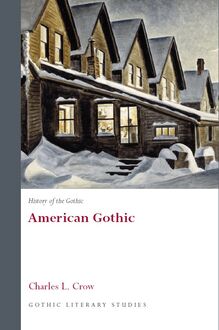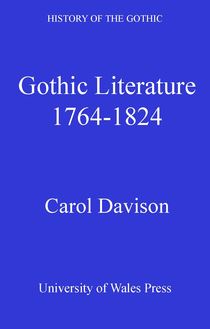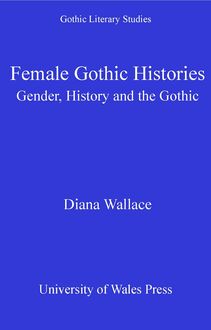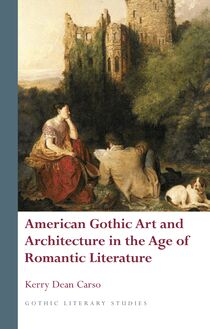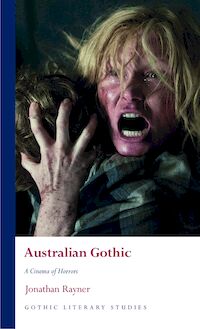Australian Gothic , livre ebook
148
pages
English
Ebooks
2022
Vous pourrez modifier la taille du texte de cet ouvrage
Obtenez un accès à la bibliothèque pour le consulter en ligne En savoir plus
Découvre YouScribe en t'inscrivant gratuitement
Découvre YouScribe en t'inscrivant gratuitement
148
pages
English
Ebooks
2022
Vous pourrez modifier la taille du texte de cet ouvrage
Obtenez un accès à la bibliothèque pour le consulter en ligne En savoir plus
Publié par
Date de parution
01 juin 2022
Nombre de lectures
2
EAN13
9781786838919
Langue
English
The term ‘Gothic’ has been applied to examples of Australian cinema since the 1970s, often in arbitrary and divergent ways. This book examines a wide range of Australian films to trace their Gothic resemblances, characteristics and meanings. By concentrating on the occurrence of Gothic motifs, characters, landscapes and narratives, it argues for the recognition and relevance of a coherent Gothic heritage in Australian film. A plethora of Gothic representatives are considered in relation to four consistent and illuminating continuities (images of the family, ideas of monstrosity, generic hybridity and the occurrence of the sublime), and this study debates the appearance and asserts the significance of Australian Gothic films within their national, cultural, literary and cinematic traditions.
LIST OF ILLUSTRATIONS
INTRODUCTION
FAMILIARITY
MONSTROSITY
HYBRIDITY
SUBLIMITY
CONCLUSION
FILMOGRAPHY
BIBLIOGRAPHY
INDEX
Publié par
Date de parution
01 juin 2022
Nombre de lectures
2
EAN13
9781786838919
Langue
English
AUSTRALIAN GOTHIC
SERIES PREFACE
Gothic Literary Studies is dedicated to publishing groundbreaking scholarship on Gothic in literature and film. The Gothic, which has been subjected to a variety of critical and theoretical approaches, is a form which plays an important role in our understanding of literary, intellectual and cultural histories. The series seeks to promote challenging and innovative approaches to Gothic which question any aspect of the Gothic tradition or perceived critical orthodoxy. Volumes in the series explore how issues such as gender, religion, nation and sexuality have shaped our view of the Gothic tradition. Both academically rigorous and informed by the latest developments in critical theory, the series provides an important focus for scholarly developments in Gothic studies, literary studies, cultural studies and critical theory. The series will be of interest to students of all levels and to scholars and teachers of the Gothic and literary and cultural histories.
SERIES EDITORS
Andrew Smith, University of Sheffield
Benjamin F. Fisher, University of Mississippi
EDITORIAL BOARD
Kent Ljungquist, Worcester Polytechnic Institute Massachusetts
Richard Fusco, St Joseph’s University, Philadelphia
David Punter, University of Bristol
Chris Baldick, University of London
Angela Wright, University of Sheffield
Jerrold E. Hogle, University of Arizona
For all titles in the Gothic Literary Studies series visit www.uwp.co.uk
Australian Gothic
A Cinema of Horrors
Jonathan Rayner
© Jonathan Rayner, 2022
All rights reserved. No part of this book may be reproduced in any material form (including photocopying or storing it in any medium by electronic means and whether or not transiently or incidentally to some other use of this publication) without the written permission of the copyright owner except in accordance with the provisions of the Copyright, Designs and Patents Act. Applications for the copyright owner’s written permission to reproduce any part of this publication should be addressed to the University of Wales Press, University Registry, King Edward VII Avenue, Cardiff CF10 3NS.
www.uwp.co.uk
British Library Cataloguing-in-Publication Data
A catalogue record for this book is available from the British Library.
ISBN 978-1-78683-889-6 eISBN 978-1-78683-891-9
The right of Jonathan Rayner to be identified as author of this work has been asserted in accordance with sections 77 and 79 of the Copyright, Designs and Patents Act 1988.
The publisher has no responsibility for the persistence or accuracy of URLs for any external or third-party internet websites referred to in this book, and does not guarantee that any content on such websites is, or will remain, accurate or appropriate.
This book is dedicated to Bryan Burns, and the fallacy of the Self-Assembly Chair.
C ONTENTS
List of Illustrations
Introduction
1 Familiarity
2 Monstrosity
3 Hybridity
4 Sublimity
Conclusion: A National Cinema of Horrors
Filmography
Bibliography
L IST OF I LLUSTRATIONS
Figure 1. Hoon Perversity Challenge: Wolf Creek 2
Figure 2. Sock-Horror: Dying Breed
Figure 3. ‘Am I too outspoken?’: The Loved Ones
Figure 4. Bedtime Story: The Babadook
Figure 5. ‘Warning to Travellers’: Wolf Creek
Figure 6. ‘Gungilee means weeping’: Killing Ground
Figure 7. ‘So lucky to be single’: Lost Gully Road
Figure 8. The landscape is a map: Mystery Road
Figure 9. ‘Waiting a million years’: Picnic at Hanging Rock
Figure 10. The sublime road: Mad Max
Figure 11. The historical crime scene: Primal
Introduction
‘Australian Gothic Cinema’, Question Mark
This book sets out to collate, address, analyse and interpret recurring, interlocking and readable currents, trends and tropes that have emerged within Australian horror films since the 1970s. Differently defined and discerned characteristics gathered under the appellation of ‘Australian Gothic’ have been used to distinguish significant and persistent themes, narratives and images within contemporary Australian filmmaking. As a term applied widely and repeatedly to diverse examples of Australian cinema, which arguably represent instances of a variety of more discrete genres or recognisable ‘film types’, the label of ‘Australian Gothic’ has been employed, explored, championed and challenged in critical responses across several decades of Australian filmmaking. 1 The regular harnessing of this term has gone hand in hand not simply with the questioning of its appropriateness, but also with an implicit or explicit probing of its definition. The application of the term ‘Gothic’ to Australian films has evinced a fluidity equal to its frequency. It has inferred a cohesiveness belying critical controversies around it, its place within an evaluation of the commercial and cultural profile of Australian films and accruing around the role and importance of the national cinema itself. Repeated application and acceptance of ‘Australian Gothic’ as a category has nonetheless left open to productive debate what exactly is Gothic and indeed Australian about these films.
While the pertinent application of the term ‘Gothic’ to Australian cinema begins with the near-term retrospective responses of the 1980s to examples of renewed film production in the 1970s, its continuance (as well as its continual reappraisal) sets it apart from what might otherwise be comparable appellations and occurrences in other national cinemas. Gothic cycles in, for example, British and Italian cinema have been more historically and critically localised to fewer, specific decades. Barry Forshaw’s account of Gothic manifestations in British cinema concentrates on the meanings behind the convergence of specific literary and cinematic traditions of national horror: the Gothic literary precedents of Mary Shelley and Bram Stoker, and the adaptation, extension and recapitulation of the characters, themes and tropes of their narratives in (above all) the films produced by the Hammer studio in the 1950s and 1960s. 2 For Forshaw, it is Hammer’s ‘imaginative (and, for the time, sensational) reinvention of Gothic material’ that epitomises a determinedly commercial, populist and chronologically contained version of national genre filmmaking. 3 The post-war establishment’s negative reaction to the coalescence and commercial success of this British version of ‘refulgently coloured horror and carnality’ is, for Forshaw, identical to the censorious contemporary response to novelistic horror in the ‘romantic strain’ of eighteenth-century literature. 4 A catering to popular taste and a confrontation with censorship are the common characteristics, rather than any interpretable comparison in their cultural moments (although literary and cinematic examples appeared in both cases in the aftermaths of European social disruption, large-scale war and political change). This suggests that the Gothic surges and resurges particularly during cultural shifts and upheavals, and functions to reflect them.
This currency of eighteenth and nineteenth-century Gothic literature in British cinema produces a significant synergy with the case of Australian Gothic, and aspects of cultural and national identity. Jane Stadler notes how ‘Gothic narratives followed colonial expansion’ and that ‘the period during which Gothic novels were most popular coincided with the colonisation of Australia in 1788 and convict transportation through the 1860s’. 5 Gothic literature is not only contemporary with the founding of Australia, as a tone and perspective it is also ‘transported’, resettled and unsettled in the colony, where its probing of the uncanny encountered in human society and the natural landscape acquired new materials and renewed relevance. The character and consequences of colonial-era encounters with the Australian continent and landscape have meant that, as Ken Gelder has observed, the ‘imported genre’ of the Gothic in literary and visual terms has proved adept in ‘adjusting’ to (and articulating) ‘local predicaments’. 6 These ‘predicaments’ can be summarised as being principally inspired by or arising from the ‘apparent emptiness’ of the Australian landscape, which challenged colonial endeavours of exploration and settlement, and confronted both wider cultural shortcomings and personal, individual flaws, paradoxically ‘bringing endless wide-open space and the claustrophobia of confinement uncannily together’. 7 The Australian landscape’s potential for occurrences of the sublime, and its inevitable description as ‘uncanny’ (residing in its difference from northern hemisphere environments and its apparent inhospitableness and indifference to the colonial enterprise), acknowledges the aptness of horrified responses to the Australian environment. The continent’s alien and alienating physical geography, the colonists’ circumstances of willing and unwilling transportation to it, and the contradictions of their literal and metaphorical confinement within its measureless expanses, work to mobilise a Gothic vocabulary of psychological and sublime extremity. Running counter to a colonial, proprietorial and rationalising view of the land as tameable, negotiable and exploitable, a contemporary and continuing Australian Gothic literary response to the land suggests the subversion of this perspective in its being unreasonable and unnavigable in and as nature, evincing not patriarchal control and profit, but instead precipitating personal, existential and cultural crises. Assertive narratives of settlement and control are thwarted or perverted by ‘an occulted Australian bush’. 8 With the landscape occupying an often proud but paradoxical place in Australian cinematic representation, the aptness of the Gothic label becomes apparent on these ‘grounds’.
Extrapolating from this imported but naturalised literary tradition, the initial coining of the term ‘Australian Gothic’ in relation to films, and the preliminary definitions of its an



